Text

Vancleavea campi at the bottom of a river.
An extrange semi-aquatic non-archosaurian archosauriform from the Late Triassic of North America.
465 notes
·
View notes
Text

A male eudimorphodon ventures down to the forest to hunt for suitable nesting material.
667 notes
·
View notes
Text

Deep breaths everyone.
Just relax with Nothosaurus mirabilis.
589 notes
·
View notes
Text
A Triassic Weirdo is any organism or group of organisms that first appeared in the Triassic and last appeared in the Triassic, with no descendants reaching the Jurassic. As this period was preceded by a major mass extinction, and followed by a major mass extinction, this leads to a *lot* of very unique organisms for the time period.
208 notes
·
View notes
Photo

A leggy little lagosuchus chases down its meal.
328 notes
·
View notes
Photo
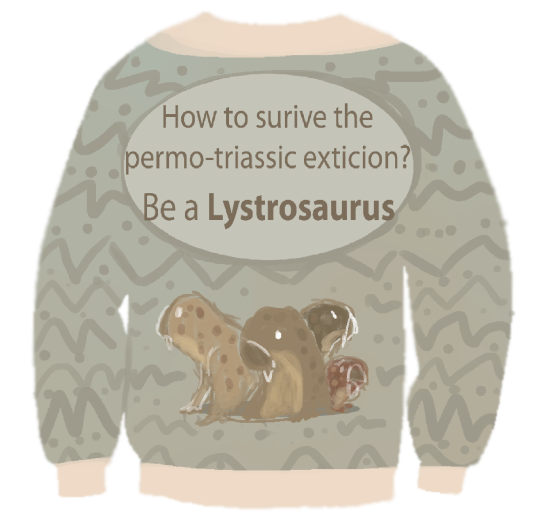

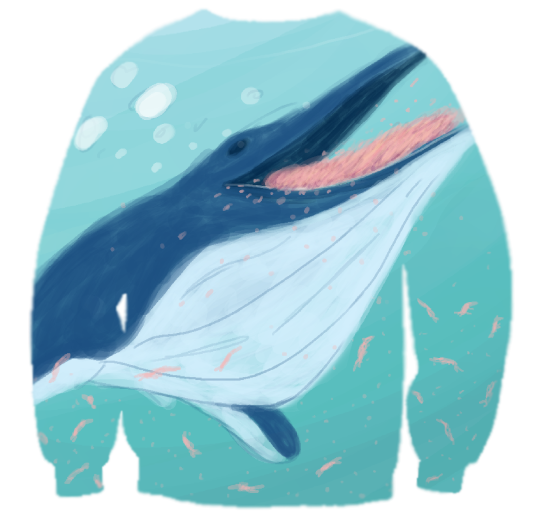
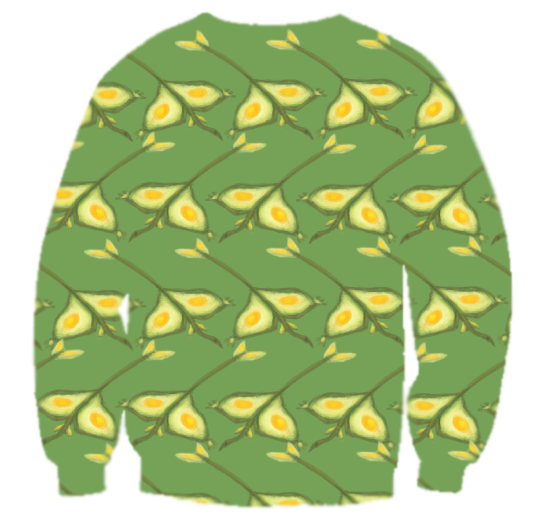
hay kids do you want some, triassic jumpers?
278 notes
·
View notes
Link
The almost-complete fossil dates back 228 million years and is bigger than a double bed.
366 notes
·
View notes
Photo

Final for Shringasaurus indicus. 247.2 million years ago, during the Middle Triassic Period, Shringasaurus roamed the what would become Madhya Pradesh, India. At the time the world was very different, many of the animal groups that exist today were still forming and that resulted in some truly weird adaptations, including animals with similar traits and appearances to animals that exist today that are not closely related at all.
Shringasaurus (it’s name coming from the sanskrit word “śṛṅga” for “horn” and greek for “lizard”) was a member of a group called Allokotosaurs, a group of reptiles that were related but not part of the cladistic grouping of Archosaurs, the group that includes crocodiles, dinosaurs, pterosaurs, and modern birds. It has also been called a stem-archosaur as it appears to be part of an earlier lineage that split before the evolution of true archosaurs.
It was about 9.8 to 13.1 feet in length and was distinguished by it’s long neck and superaorbital brow horns (similar to those of some ceratopsian dinosaurs. It’s teeth indicate that it was an herbivore, possibly using it’s long neck to reach higher foliage than other competing animals.
Shringasaurus indicus is the type species for it’s genus and is still being studied as of it’s very recent discovery in 2017. Who knows what it will tell us about this unique era in Earth’s history?
485 notes
·
View notes
Photo

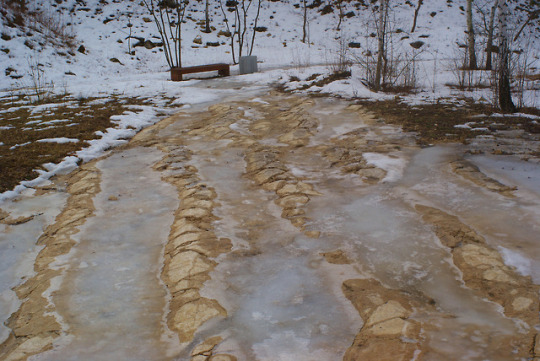
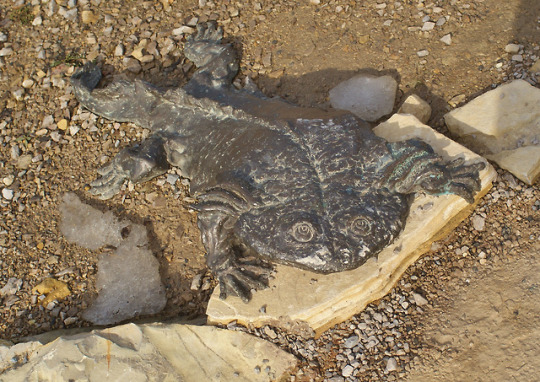
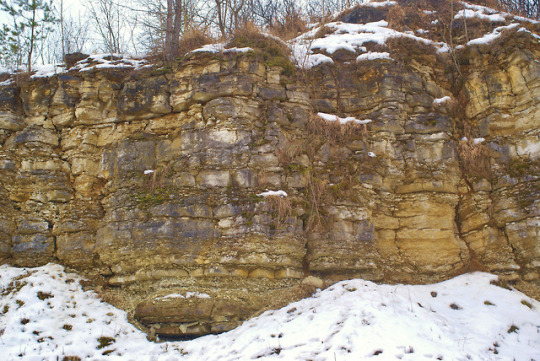
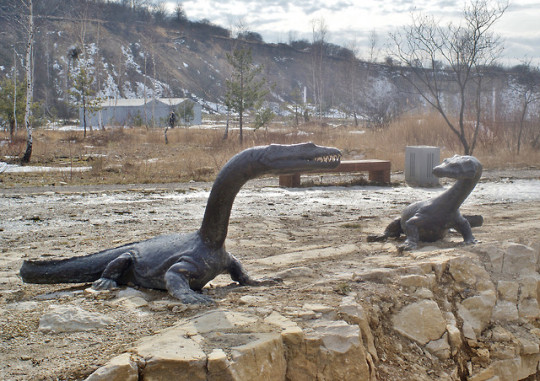
Former Triassic limestones quarry in Sadowa Góra (Orchard Mountain) in Jaworzno, Upper Silesia. Poland. They originated in shallow epicontinental sea and are rich in marine fossils like brachiopods, bivalves and crinoids. Bones of some aquatic reptiles were also found here like placodont rib and various fragments of nothosaurs skeletons. The second photo shows mega-ripple marks which occur at the bottom of the quarry. Such structures, many times wider than typical ripple marks, serve as surviving evidence of triassic powerful tropical tornados or maybe even tsunami waves, disturbing what was then the bottom of the sea. Reconstructions of Triassic fauna include the dinosauriform Silesaurus, temnospondyl amphibian Plagiosaurus and sauropterygian Nothosaurus.
488 notes
·
View notes
Photo

DEAD MEME! DEAD MEME!
Tag urself poorly drawn Triassic fauna edition.
2K notes
·
View notes
Text
I’m still unsure which crime was more unforgivable: the existence of drepanosaurs in the first place, or their extinction meaning I can’t laugh at them to their faces now
620 notes
·
View notes
Text
Neotheropoda

Source: http://www.sciencemag.org/news/2014/10/new-meat-eating-dinosaur-lived-wake-mass-extinction
Group: Neotheropoda
Classification: Cellular Life, Archaea, Proteoarchaeota, Eukaryota, Unikota, Opisthokonta, Holozoa, Filozoa, Metazoa, Eumetazoa, Planulozoa, Bilatera, Nephrozoa, Deuterostomia, Chordata, Craniata, Vertebrata, Gnathostomata, Eugnathostomata, Teleostomi, Euteleostomi, Sarcopterygii, Rhipidistia, Tetrapodomorpha, Eotetrapodiforms, Elpistostegalia, Stegocephalia, Tetrapoda, Reptiliomorpha, Anthracosauria, Batrachosauria, Cotylosauria, Amniota, Sauropsida, Eureptilia, Romeriida, Diapsida, Neodiapsida, Sauria, Archosauromorpha, Archelosauria, Archosauriformes, Crurotarsi, Archosauria, Avemetatarsalia, Ornithodira, Dinosauromorpha, Dinosauriformes, Dinosauria, Saurischia, Eusaurischia, Theropoda
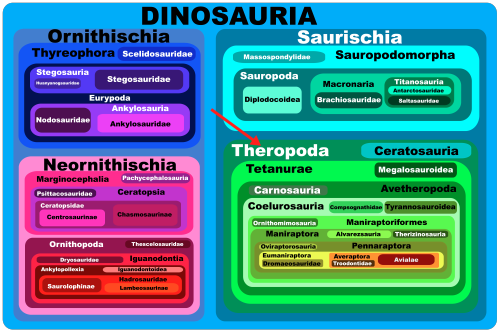
Definition: The group including the most recent common ancestor of Ceolophysis and modern birds, and all of that animal’s descendants

Organisms Within: Zupaysaurus, Tachiraptor, Dilophosauridae (not examined here), Coelophysoidea (not examined here), Averostra (not examined here), & two miscellaneous genera without further placement.
Time Range: Shown below, numbers on the left in millions of years. Though the only basal Neotheropods known are from the Triassic-Jurassic boundary, members of other groups are present much earlier than that, about 220 million years ago, implying that they must have evolved at around that time or older.
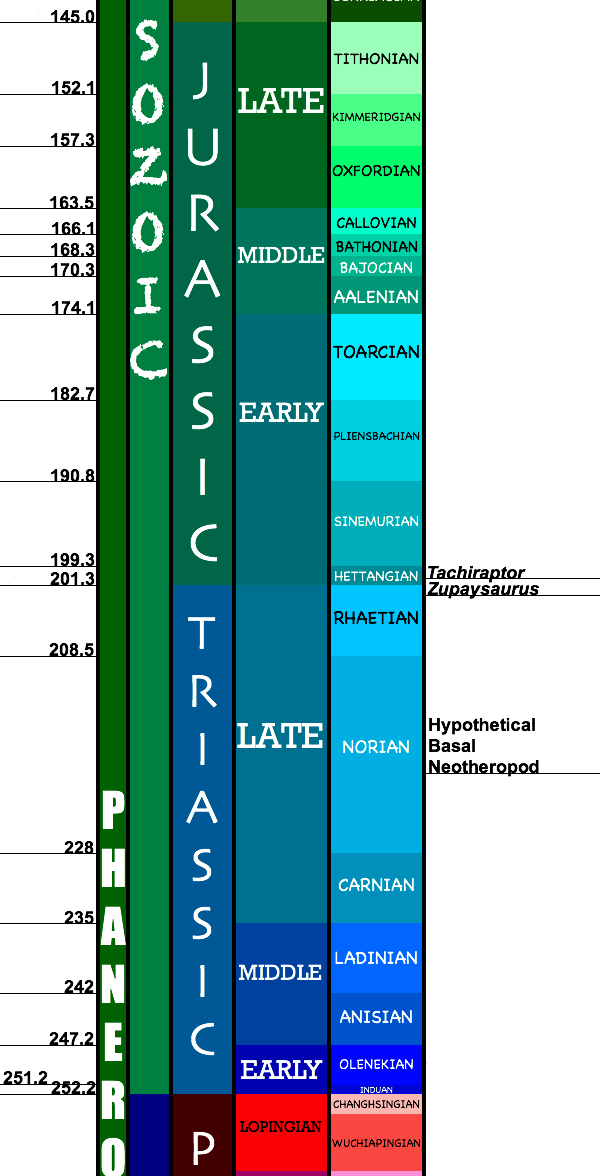
Characteristics:
Neotheropods differ from basal theropods mainly on a few skeletal points. The ilium bone in the pelvis, expanded towards the top of the animal (dorsally). The snout is more narrow than in basal theropods, there are more vertebrae fused to the hips, there is a complete loss of the fifth digit of the foot (as shown below), and a general stiffening of the legs overall.
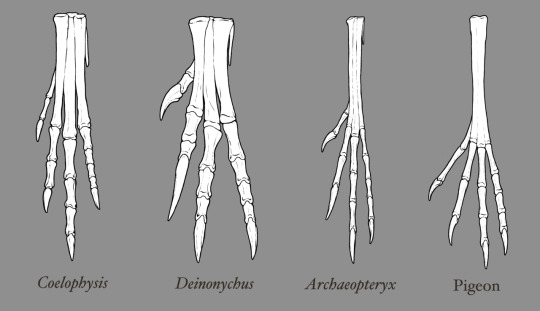
By @ewilloughby
Like all early dinosaurs, Neotheropods were probably covered in a layer of primitive feathers - though some theropods groups would later lose feathers, the general line leading up to birds must have kept them, given that birds have feathers. They were bipedal, fast predators, and basal members of Neotheropoda were probably outcompeted by later animals, and even during their existence Coelophysoids were far more common.

Source: @alphynix
Fossil Locations: It is fairly likely that Neotheropods also originated in Argentina, during that very rapid early diversification of dinosaurs in the region. This assessment is based mainly on the presence of basal theropods mainly in the region, though its possible that it also occurred in North America, where many Coelophysoids lived. Coelophysoids have also been found in Europe and Asia, and so given this widespread range of this group and its early evolution, as well as the locations of basal theropods, its reasonable to suppose that Argentina is where they started, unless evidence to the contrary comes to light.
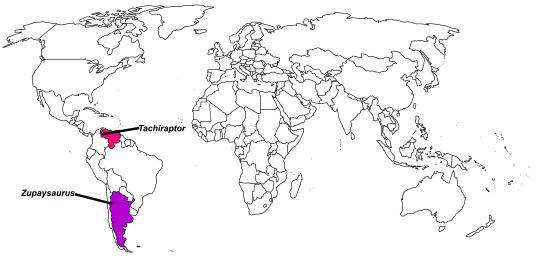
Biogeography: Neotheropods spread throughout the globe, as described above; this was relatively easy due to Panagaea, however, most Coelophysoids congregated around North America and Europe. The two basal members of the group stayed in South America. Maps from Dr. Christopher Scotese.
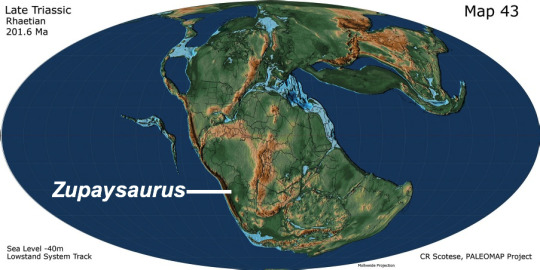

Read more about Zupaysaurus here!
Read more about Tachiraptor here!
Read more about Coelophysoidea here!
Posts on Dilophosauridae and Averostra to come soon!
Sources:
https://en.wikipedia.org/wiki/Neotheropoda
http://palaeos.com/vertebrates/theropoda/neotheropoda.html
https://en.wikipedia.org/wiki/Zupaysaurus
https://en.wikipedia.org/wiki/Tachiraptor
Shout out goes to @chequitablr!
Miscellaneous Neotheropods not examined here that do not have further placement (links added as I do posts on them):
Altispinax
Szechuanosaurus
151 notes
·
View notes
Text
Coelophysoidea
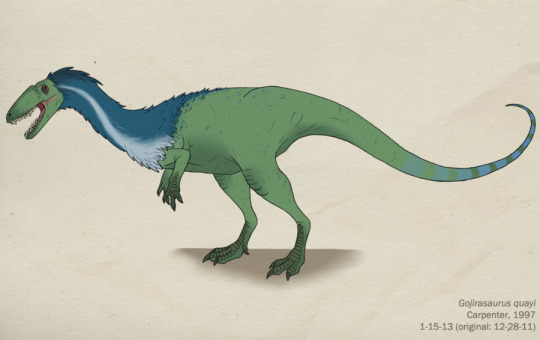
Art from http://green-mamba.deviantart.com/art/001-GOJIRASAURUS-QUAYI-279964835
Group: Coelophysoidea
Classification: Cellular Life, Archaea, Proteoarchaeota, Eukaryota, Unikota, Opisthokonta, Holozoa, Filozoa, Metazoa, Eumetazoa, Planulozoa, Bilatera, Nephrozoa, Deuterostomia, Chordata, Craniata, Vertebrata, Gnathostomata, Eugnathostomata, Teleostomi, Euteleostomi, Sarcopterygii, Rhipidistia, Tetrapodomorpha, Eotetrapodiforms, Elpistostegalia, Stegocephalia, Tetrapoda, Reptiliomorpha, Anthracosauria, Batrachosauria, Cotylosauria, Amniota, Sauropsida, Eureptilia, Romeriida, Diapsida, Neodiapsida, Sauria, Archosauromorpha, Archelosauria, Archosauriformes, Crurotarsi, Archosauria, Avemetatarsalia, Ornithodira, Dinosauromorpha, Dinosauriformes, Dinosauria, Saurischia, Eusaurischia, Theropoda, Neotheropoda

Definition: Neotheropods more closely related to Ceolophysis than to Ceratosaurus, Carnotaurus, and Passer

Organisms Within: Gojirasaurus?, Dolichosuchus?, Halticosaurus?, Liliensternus, Lophostropheus, Podokesaurus, Sarcosaurus, Coelophysidae (not examined here)
Time Range: Shown below, numbers on the left in millions of years; organisms in red questionable members of the group. Coelophysoids first appeared fairly early in dinosaurian evolution, further pointing to the evidence that early dinosaurs diversified rapidly. They went extinct not long into the Jurassic period, as other small theropods evolved and outcompeted them for resources.

Characteristics:
Coelophysoids were a group of slender, lightly built, fast running theropods that had an extremely flexible jaw, allowing for them to have a wider gape with which to grab potential prey. They were very specialized predators, and in an ecosystem in which most of the other predators were of the bulky and large sort, they were specialized to be the opposite - small, and fast.

Art from http://www.paleofile.com/Dinosaurs/Theropods/Lophostropheus.asp
Like other early dinosaurs, Coelophysoids were most likely covered in primitive feathers, and were small, bipedal animals with lightweight bones. They grew in size from 1 to 6 meters in length. They may have lived in packs to hunt, and were very successful prior to the Jurassic-Triassic extinction, after which their numbers dwindled. Some members of the group grew crests on their snouts, which were probably used for display.
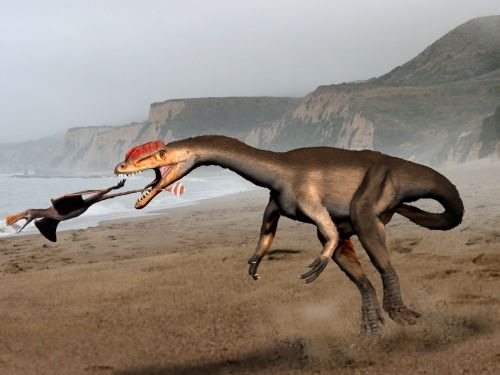
Art from https://en.wikipedia.org/wiki/Liliensternus
Fossil Locations: Shown below; red means an organism is a questionable part of the group; colored countries are where fossil locations have been found. Though it is probable that Ceolophysoids may have originated in South America, due to their early appearance in Dinosaurian evolution, it is possible that they evolved elsewhere, given that most Coelophysoids (including Coelophysids, which we’ll look at next week) lived elsewhere.
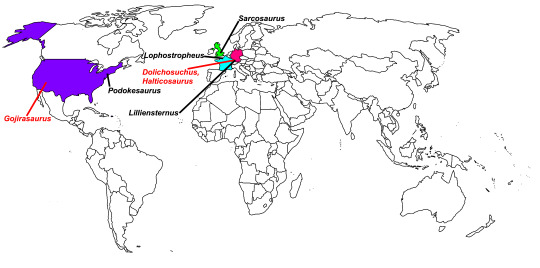
Biogeography: Names in red indicate questionable members of the group; names in white definite ones. Coelophysoids lived in North America and Europe. All maps from Dr. Christopher Scotese
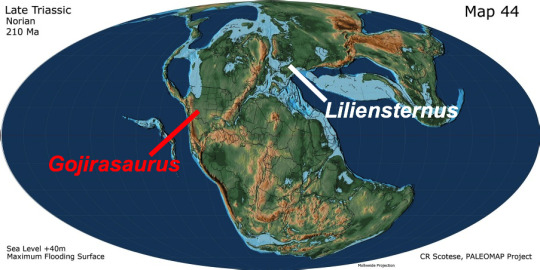
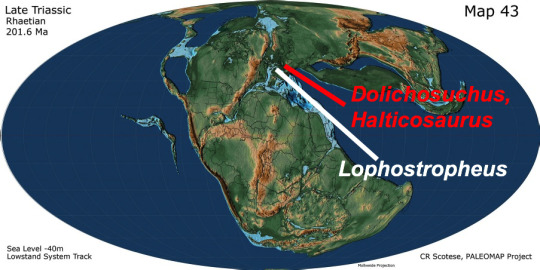
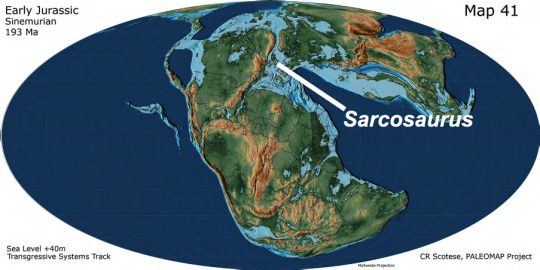
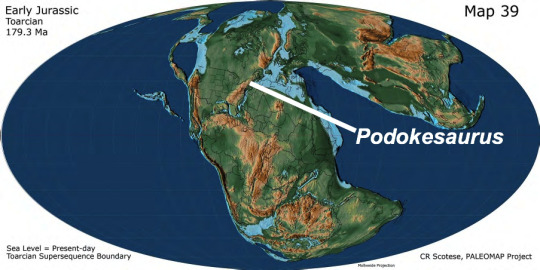
Read more about Dolichosuchus here!
Read more about Halticosaurus here!
Read more about Gojirasaurus here!
Read more about Liliensternus here!
Read more about Lophostropheus here!
Read more about Podokesaurus here!
Read more about Sarcosaurus here!
Post on Coelophysidae to come next week!
Sources:
http://en.wikipedia.org/wiki/Sarcosaurus
http://en.wikipedia.org/wiki/Podokesaurus
http://en.wikipedia.org/wiki/Lophostropheus
http://en.wikipedia.org/wiki/Liliensternus
http://en.wikipedia.org/wiki/Gojirasaurus
http://en.wikipedia.org/wiki/Halticosaurus
http://en.wikipedia.org/wiki/Dolichosuchus
Shout out goes to @shadow73093!
121 notes
·
View notes
Text
Coelophysidae
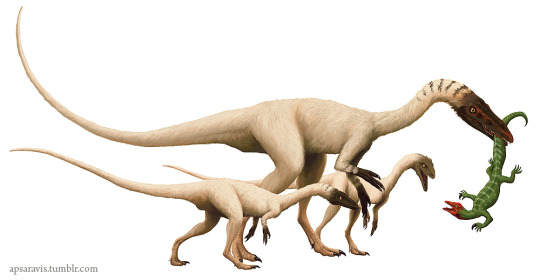
Art from http://apsaravis.deviantart.com/art/Coelophysis-bauri-405981470
Group: Coelophysidae
Classification: llular Life, Archaea, Proteoarchaeota, Eukaryota, Unikota, Opisthokonta, Holozoa, Filozoa, Metazoa, Eumetazoa, Planulozoa, Bilatera, Nephrozoa, Deuterostomia, Chordata, Craniata, Vertebrata, Gnathostomata, Eugnathostomata, Teleostomi, Euteleostomi, Sarcopterygii, Rhipidistia, Tetrapodomorpha, Eotetrapodiforms, Elpistostegalia, Stegocephalia, Tetrapoda, Reptiliomorpha, Anthracosauria, Batrachosauria, Cotylosauria, Amniota, Sauropsida, Eureptilia, Romeriida, Diapsida, Neodiapsida, Sauria, Archosauromorpha, Archelosauria, Archosauriformes, Crurotarsi, Archosauria, Avemetatarsalia, Ornithodira, Dinosauromorpha, Dinosauriformes, Dinosauria, Saurischia, Eusaurischia, Theropoda, Neotheropoda, Coelophysoidea
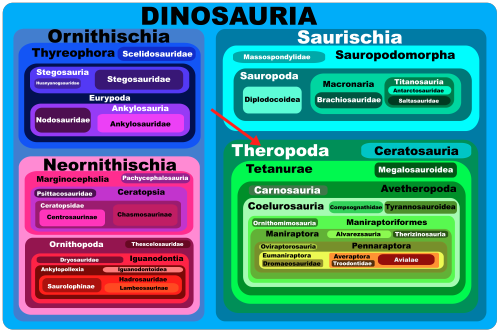
Definition: All descendants of the most recent common ancestor of Coelophysis bauri and Procompsognathus triassicus
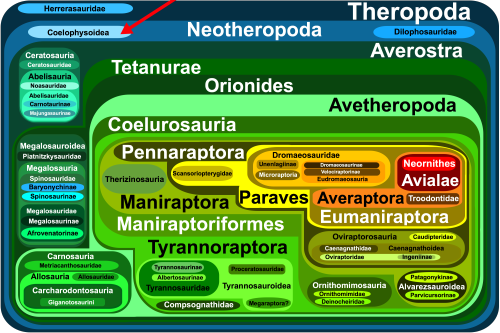
Organisms Within: Coelophysis, Camposaurus, Panguraptor, Procompsognathus, Pterospondylus, Segisaurus, Lepidus
Time Range: Shown below, numbers on the left in millions of years. Coelophysids first appeared around when Coelophysoids did, indicating once again the rapid diversification of early dinosaurs and early theropods. They went extinct in the Early jurassic, as other small theropods evolved and outcompeted them for resources, same as their less derived Coelophysoid cousins.

Characteristics:
Coelophysoids were small, gracile predators that were extremely common in the Late Triassic and Earliest Jurassic periods. The most famous, of course, is Coelophysis, with multiple species assigned to the genus from many locations. Some members of the group had small crests on their heads, that were probably used for display; in general they were fast, built for avoiding larger predators and hunting prey such as insects, lizards, early mammal relatives, things in general much smaller than they were that they would have to run and catch, potentially with their hands.

Art from https://en.wikipedia.org/wiki/Coelophysidae
Coelophysids were probably covered in protofeathers, like all early dinosaurs, and while it has been thought that they were pack hunters, evidence of flocking has not been found; rather, large deposits of fossils of these animals in places like the Coelophysis ghost ranch were due to phenomena such as flash floods and watering holes. Members of the group lived fast, and died young, maturing quickly and were probably warm blooded and very active.
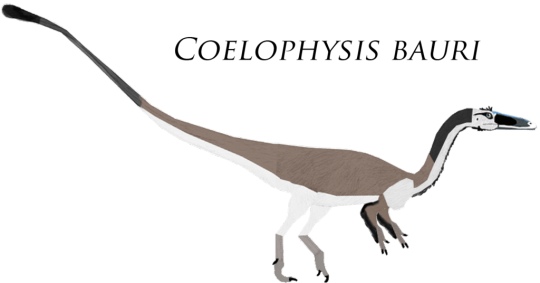
Art from http://alpha-dilophosaurus.deviantart.com/art/Coelophysis-bauri-565335271
Fossil Locations: Coelophysids have been found throughout the globe, and given their rapid and early in the history of dinosaurs diversification it’s relatively likely that they evolved in South America, but it’s also possible they originated in the North American southwest. It is hard to tell with the large gaps this group has in the fossil record. Colored countries have fossil locations.
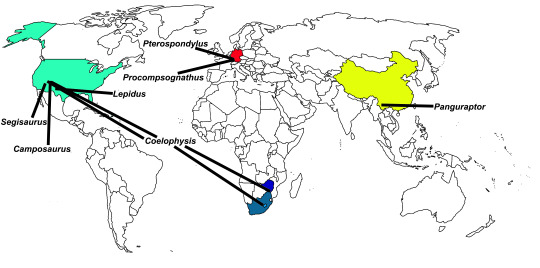
Biogeography: The Coelophysoids lived for a long period of time and were present in a wide variety of locations, as shown below.


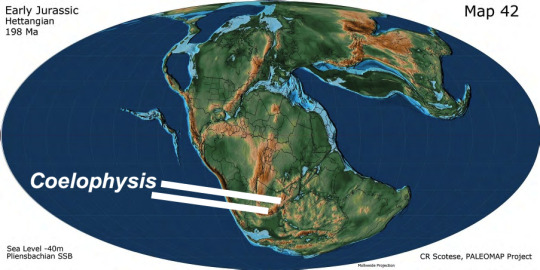
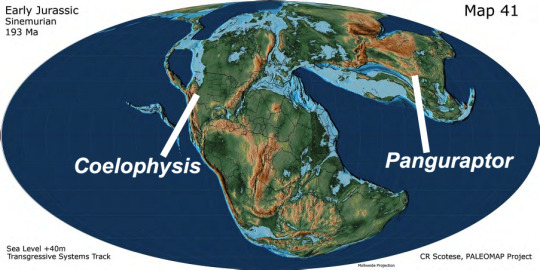

Read more about Coelophysis here and here!
Read more about Camposaurus here!
Read more about Panguraptor here!
Read more about Procompsognathus here!
Read more about Pterospondylus here!
Read more about Segisaurus here!
Read more about Lepidus here!
Sources:
https://en.wikipedia.org/wiki/Coelophysidae
https://en.wikipedia.org/wiki/Panguraptor
https://en.wikipedia.org/wiki/Lepidus_praecisio
https://en.wikipedia.org/wiki/Procompsognathus
https://en.wikipedia.org/wiki/Pterospondylus
https://en.wikipedia.org/wiki/Segisaurus
https://en.wikipedia.org/wiki/Camposaurus
https://en.wikipedia.org/wiki/Coelophysis
https://en.wikipedia.org/wiki/Coelophysis_rhodesiensis
https://en.wikipedia.org/wiki/Coelophysis_kayentakatae
Shout out goes to @ineedfoodoriwilldie!
108 notes
·
View notes
Text
Group in Depth: Basal Theropoda
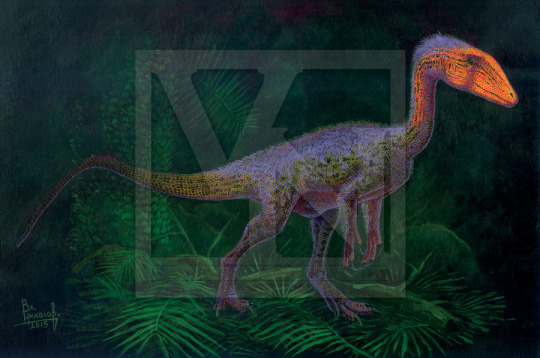
Source: http://t-pekc.deviantart.com/art/Tawa-hallae-546069775
Group: Theropoda
Classification: Cellular Life, Archaea, Proteoarchaeota, Eukaryota, Unikota, Opisthokonta, Holozoa, Filozoa, Metazoa, Eumetazoa, Planulozoa, Bilatera, Nephrozoa, Deuterostomia, Chordata, Craniata, Vertebrata, Gnathostomata, Eugnathostomata, Teleostomi, Euteleostomi, Sarcopterygii, Rhipidistia, Tetrapodomorpha, Eotetrapodiforms, Elpistostegalia, Stegocephalia, Tetrapoda, Reptiliomorpha, Anthracosauria, Batrachosauria, Cotylosauria, Amniota, Sauropsida, Eureptilia, Romeriida, Diapsida, Neodiapsida, Sauria, Archosauromorpha, Archelosauria, Archosauriformes, Crurotarsi, Archosauria, Avemetatarsalia, Ornithodira, Dinosauromorpha, Dinosauriformes, Dinosauria, Saurischia, Eusaurischia

Definition: All dinosaurs more closely related to Megalosaurus than to Apatosaurus
Organisms Within: Daemonosaurus, Eodromaeus, Tawa, Herrrasauridae (not examined here), Neotheropoda (not examined here), & miscellaneous nomen dubium & not formally described genera (not examined here)
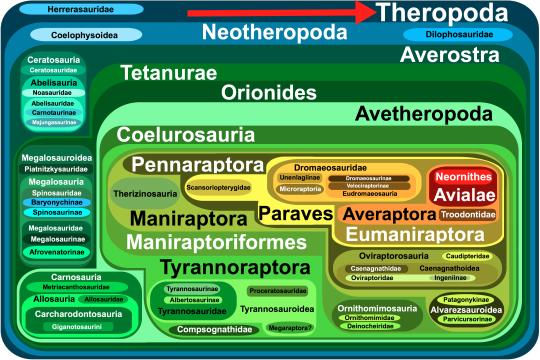
Time Range: Shown below; numbers on the left are in millions of years. It is clear that Theropods and Sauropodomorphs diverged from one another early in Saurischian evolution, and basal Theropods lasted longer in the Triassic than basal Saurischians did, though they probably went extinct (with more derived theropod lineages surviving) at the end of the Triassic.
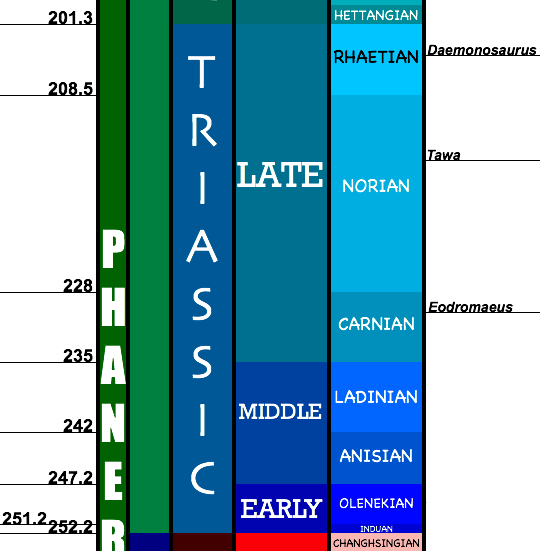
Characteristics: Small carnivorous Saurischians, one of the two major lineages of Eusaurischia, the other being Sauropodmorphs. Theropoda comprises a wide range of dinosaurs from Coelophysis to Tyrannosaurus to Velociraptor to the modern house sparrow and all modern birds. The early ones, however, were all small gracile bipedal carnivores, with long necks and tails.

Source: https://en.wikipedia.org/wiki/Eodromaeus_murphi
They were probably covered with protofeathers based on phylogenetic bracketing; and though they look similar to the basal Saurischians of last week, they were distinct in being a part of only the Theropoda line, and having diverged from the Sauropodomorphs. Tawa, however, may be a Coelophysoid, an even more derived Theropod group.

Source: http://www.smithsonianmag.com/science-nature/daemonosaurus-shakes-up-the-early-history-of-dinosaurs-175320534/?no-ist
Fossil Locations: It appears that Theropods originated where dinosaurs did, in Argentina, which makes sense given their apparent early divergence from other Saurischians. They then migrated up through to North America.

(Colored = country has fossil sites; line points to the approximate fossil location).
Biogeography: At the time of the Triassic, all the land masses were combined into one supercontinent, the famous Pangaea. Though the major locations of the continents remained fairly unchanged over the time period these three organisms lived, each individual age is given its own map below. All maps taken from Dr. Christopher Scotese.


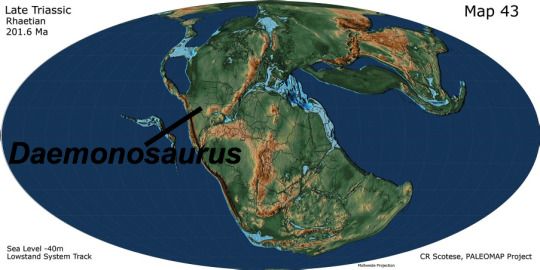
It appears that basal Theropods migrated up to the modern American Southwest, though later Theropod distribution covers all continents.
Read more about Eodromaeus here
Read more about Tawa here
Read more about Daemonosaurus
Read more about Herrerasauridae here
Read more about Neotheropoda here
Sources:
https://en.wikipedia.org/wiki/Theropoda
https://en.wikipedia.org/wiki/Daemonosaurus
https://en.wikipedia.org/wiki/Eodromaeus
https://en.wikipedia.org/wiki/Tawa_(dinosaur)
Shoutout goes to @girlyscience-things
Miscellaneous Theropods not examined here that do not have further placement (links added as I do posts on them):
“Capitalsaurus”
Coeluroides
“Kagasaurus”
Inosaurus
Velocipes
Tanystrosuchus
109 notes
·
View notes

